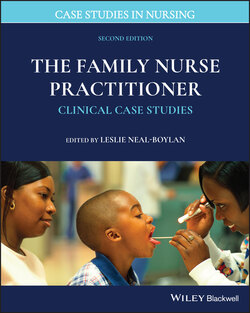Читать книгу The Family Nurse Practitioner - Группа авторов - Страница 36
ОглавлениеCase 4.5 Disruptive Behavior
By Mikki Meadows‐Oliver, PhD, RN, FAAN
SUBJECTIVE
This mother presents with 6‐year‐old Jason with concerns about his increasingly disruptive behavior at home. She reports that Jason has always been a difficult child to manage, often is irritable, angers easily, and resists any changes in routine. He argues constantly with his 8‐year‐old sister about simple activities. He grabs her toys, interferes with her play, and has begun to be more physically aggressive with her. Jason argues with his mother and grandmother when any limits are put on his behavior. He is uncooperative regarding the simplest of requests like coming to the table for meals, turning off his video games, or staying in the yard. Jason has had a few good relationships with children in the neighborhood. His mother has attempted to discipline Jason through a variety of methods, such as talking, screaming, time out, losing TV and video game time, and occasional spankings. His mother reports that no methods work. She is exhausted by the attention she spends on his behavior and is frustrated facing discipline issues every day from breakfast to bedtime. She is confused because her daughter has never demonstrated these types of issues, and she used basically the same parenting strategies with her daughter as she did with Jason. His mother has not spoken with Jason’s first‐grade teacher to see if similar behaviors are occurring in school.
Diet: Jason has been a healthy child. He had some initial feeding issues as an infant with excessive irritability causing multiple formula changes. Since then he has had no food allergies or intolerances and eats a fairly well‐balanced diet with the exception of excessive juice consumption.
Elimination: No difficulties.
Sleep: Jason has had difficulty establishing nighttime sleep patterns. He continues to have difficulty with sleep onset, wakes frequently, and goes into his mother’s bed.
Past medical history: Jason was the second child born to a 27‐year‐old mother by vaginal delivery after an uneventful full‐term pregnancy. He weighed 7 lbs 9 oz and had no problems in the newborn nursery (no temperature instability, no jaundice, and no respiratory issues). He was discharged home with his mother on cow’s‐milk formula at 48 hours of age. Jason experienced a head injury with a loss of consciousness at the age of 3 years. His head CT was normal, but he was admitted to the pediatric unit for overnight observation. He has not had any obvious sequelae from this incident. Jason has had no respiratory, cardiac, neurologic, or allergic problems.
Family history: Jason’s mother has history of Hashimoto thyroiditis and depression and is medicated for both of these conditions. She is fairly adherent to her medication regime. She was an average student, graduated from high school, and works as a cashier. Jason’s 33‐year‐old father has a history of substance abuse, depression, and hypertension. He was incarcerated briefly for selling drugs and now declines all medications. He did not complete high school, has a history of delinquency and attention problems, and currently works intermittently in construction. The maternal grandparents both have well‐controlled hypertension and hypercholesterolemia. The paternal grandparents’ histories are unknown to the father since he has not had contact with them in 15 years. Jason’s sister is healthy and doing average schoolwork.
Social history: Jason’s mom is single and lives on the second floor of a 1940s 2‐family house with the maternal grandparents on the first floor. Jason’s household consists of his mother, an 8‐year‐old sister, 2 dogs, and several cats. His mother and the children have frequent contact with the father, but he is not a regular part of the household. Both parents smoke while with the children. Jason attended day care full‐time until school entry but now returns home to the care of his grandparents after school. Toward the end of his time in day care, his mom reports that she had received a few calls about Jason’s behavior, specifically some difficulties participating in group activities and following directions.
Medications: Takes no medications.
OBJECTIVE
General: Alert, active, responsive to most requests with good articulation, some fidgeting with instruments.
Vital signs: Height: 46 inches (115 cm); weight: 45 lbs (20.9 kg); heart rate: 92; respiratory rate: 18; blood pressure: 98/62.
HEENT: Normocephalic; PERRL full EOMs, normal convergence, normal discs; gray TMs with good light reflexes and landmarks. Nose is normal, midline septum, boggy turbinates. Throat reveals large tonsils, no erythema, and uvula midline.
Neck: Supple; full range of motion; thyroid not palpable; no lymphadenopathy.
Cardiac: Regular rate and rhythm; S1/S2; no murmur; pulses full and equal.
Respiratory: Clear breath sounds throughout.
Abdomen: Soft, no mass, no hepatosplenomegaly.
Genitourinary: Normal male, circumcised, testes descended ×2.
Musculoskeletal: Full range of motion for all extremities; symmetric movement.
Neurologic: Normal tone, strength, coordination, reflexes and cranial nerves II‐XII grossly intact.
Skin: Clear, dry patches on elbows and knees.
CRITICAL THINKING
1 Which diagnostic or imaging studies should be considered to assist with or confirm the diagnosis?___CBC___Thyroid studies___Lead screening___Vision screening___Hearing screening___Vanderbilt ADHD screening for school and parent___Learning disability evaluation___Pediatric Symptom Checklist
2 What is the most likely differential diagnosis and why?___Normal active behavior of early childhood___Hearing impairment___Attention‐deficit hyperactive disorder (ADHD)___Learning disability___Oppositional defiant disorder (ODD)___Conduct disorder___Depression
3 What is the plan of treatment?
4 What is the plan for follow‐up care?
5 Are there any demographic factors that might affect this case?
NOTE: The author would like to acknowledge Patricia Ryan‐Krause, MSN, APRN, who co‐authored this case in the first edition of this book.
